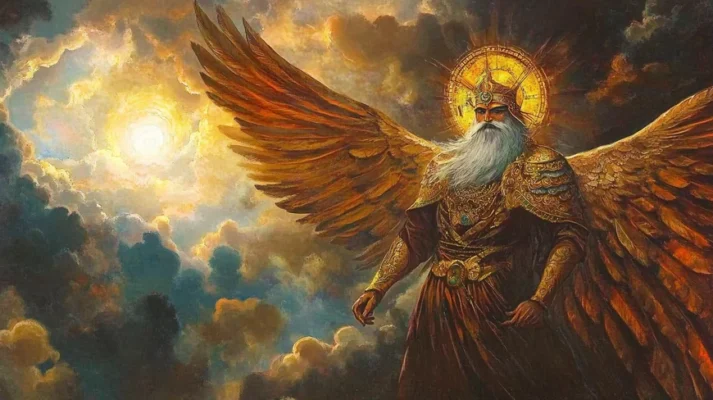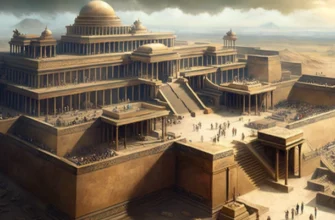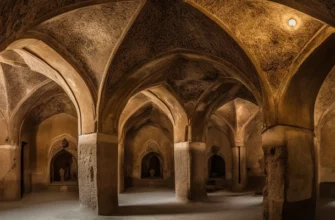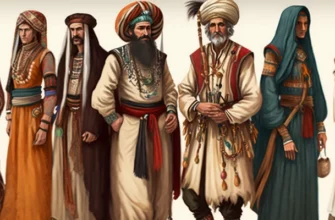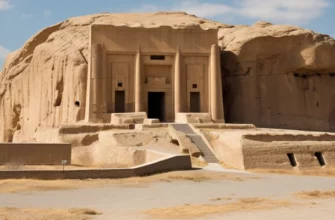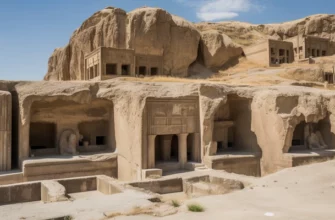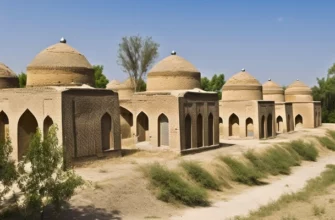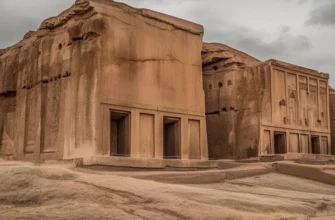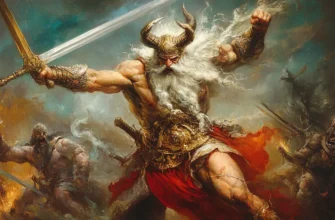Ahura Mazda is the chief god of Zoroastrianism, symbolizing light, wisdom, and goodness. He is considered the creator of the universe and the embodiment of moral truth. His name translates as “Lord of Wisdom,” and he is considered the source of all that is positive in the world.
Zoroastrianism, founded by the prophet Zarathustra, emphasizes the importance of the struggle between good and evil, where Ahura Mazda is the supreme good, and his opponent, Angra Mainyu, embodies evil. Zoroastrianism emphasizes human moral responsibility, and Ahura Mazda calls for righteousness, justice, and truth.
The symbols of Ahura Mazda are fire and light, reflecting his nature as the source of life and clarity. The worship of Ahura Mazda includes rituals, prayers, and festivals that are still celebrated today.
Today, Ahura Mazda remains an important figure in Iranian culture, influencing the worldview and values of people who follow Zoroastrianism. His teachings on benevolence and truth continue to inspire people around the world.
The significance of Ahura Mazda in Iranian culture and religion.
Ahura Mazda has a profound significance in Iranian culture and religion, primarily as the chief god of Zoroastrianism, one of the world’s oldest religions. He embodies the ideals of light, wisdom, and justice, and his image is associated with the positive moral qualities that form the basis of Zoroastrian teachings.
Ahura Mazda is the creator of the world and all living things, considered to be the source of life, as well as moral norms and values that help people make the right choices. His teachings emphasize the importance of ethics and responsibility, calling on people to adhere to truth, justice, and charity, which has significantly influenced the moral principles of Iranian culture.
The worship of Ahura Mazda includes rituals, prayers, and holidays that strengthen the community and preserve cultural traditions. Temples dedicated to Ahura Mazda serve as centers of religious life. The image of Ahura Mazda is often depicted in Iranian art and literature, symbolizing the ideals of justice and wisdom. His teachings have inspired many Iranian poets and thinkers.
Today, Ahura Mazda remains an important figure for Iranians who follow Zoroastrianism, and his teachings on goodness and truth continue to influence contemporary Iranian identity and culture.
Origin and history
The origin of Ahura Mazda and his role in the history of Zoroastrianism are an integral part of Iran’s spiritual heritage. Ahura Mazda, as the chief god of Zoroastrianism, appears in texts dating back to around the 6th century BCE, but his roots may go even deeper into the times of Indo-Aryan beliefs.
Zoroastrianism, founded by the prophet Zarathustra, opposes polytheism and has two main characters: Ahura Mazda, who embodies goodness and wisdom, and Angra Mainyu, who symbolizes evil. This dualistic concept of the struggle between good and evil became the basis of the religious philosophy of Zoroastrianism.
In early Zoroastrian texts, particularly in the Avesta, Ahura Mazda is described as omniscient, omnipotent, and just. His worship became the basis for religious practices, including prayers, sacrifices, and festivals. With the emergence of Zoroastrianism in Iran, Ahura Mazda gained widespread recognition and became a key figure in the culture and religion of ancient Iran.
Throughout history, Zoroastrianism has been influenced by various cultures and political regimes. After the Arab conquest of Iran in the 7th century, Zoroastrianism declined significantly, but Ahura Mazda remained an important figure for followers who sought to preserve their identity.
Today, although Zoroastrianism has few followers, the significance of Ahura Mazda as a symbol of light, benevolence, and morality continues to live on in Iranian culture and consciousness. His teachings on the struggle between good and evil, truth and justice continue to inspire people to this day.
The role of Ahura Mazda in Zoroastrianism
Ahura Mazda plays a central role in Zoroastrianism as the chief god and creator of the universe. In the Zoroastrian worldview, Ahura Mazda symbolizes goodness, light, and wisdom, while his antagonist, Angra Mainyu, embodies evil and chaos. This dualistic concept is the basis of the religious philosophy of Zoroastrianism, where the struggle between good and evil is a key element.
Ahura Mazda is considered omniscient and omnipotent, creating the world and all its beings with the aim of establishing order and justice. His teachings include the concept of Asha—cosmic order, truth, and justice, which is the basis of moral life. Followers of Zoroastrianism believe that adherence to the principles of Asha helps a person achieve unity with Ahura Mazda.
The cult of Ahura Mazda includes prayers, sacrifices, and holidays that strengthen faith and community. An important aspect is the ritual of fire, which symbolizes light and purity associated with Ahura Mazda. Fire is considered a sacred element that connects people with the divine.
In addition, Ahura Mazda endows people with moral responsibility, calling them to good deeds and justice. His teachings form the basis of Zoroastrian ethics, which has influenced the cultural, social, and political aspects of life in Iran.
Thus, Ahura Mazda is not only a deity but also an ethical guide for his followers, giving meaning to their existence and calling them to fight for good in the world.
Attributes and Symbols
Ahura Mazda has several key attributes and symbols that reflect his nature and role in Zoroastrianism. First, he is associated with light and fire, symbolizing purity, truth, and divine wisdom.
Fire is considered a sacred element used in rituals and prayers, emphasizing the connection between people and the deity.
Another important symbol is the “Hvoya” or “Persepolis bird,” which depicts Ahura Mazda as the protector of justice and order. This symbol is often used in art and architecture, reflecting the power and majesty of the god.
Among the attributes of Ahura Mazda, the concept of Asha is also highlighted, embodying cosmic order, justice, and truth. Asha is the ethical foundation of Zoroastrianism, calling on people to adhere to the principles of charity and morality.
Additionally, in Zoroastrian texts, Ahura Mazda is depicted accompanied by six sacred beings — the Amesha Spentas, who embody various aspects of his power, such as life, righteousness, and moral purity. These beings assist him in governing the world and maintaining order in the universe.
Thus, the attributes and symbolism of Ahura Mazda emphasize his role as the creator, protector of virtue and moral order, reflecting the important ethical principles of Zoroastrianism.
Worship and cults
The worship of Ahura Mazda is a central aspect of Zoroastrian practice, which includes various rituals, prayers, and celebrations. The main forms of worship focus on maintaining the connection between people and the deity, as well as adhering to ethical principles.
One of the most important elements is fire, which is considered a sacred symbol of Ahura Mazda. In Zoroastrian temples, or atashkeks, a sacred fire is maintained that burns continuously. Rituals around the fire include prayers and sacrifices, symbolizing purity and sacredness.
Holidays are also of great importance in honoring Ahura Mazda. One of the main holidays is Nowruz, the New Year, which is celebrated on the spring equinox. This holiday symbolizes the renewal of life, light, and the victory of good over evil. On this day, Zoroastrians perform purification rituals, give each other gifts, and celebrate with their families.
Another important aspect is prayers, which are composed of texts from the Avesta, the sacred book of Zoroastrianism. Prayers can be performed individually or in a community, and they are a way of communicating with Ahura Mazda, asking for wisdom, protection, and blessings.
Zoroastrians also observe rituals associated with life events such as birth, marriage, and death. These rituals, aimed at honoring Ahura Mazda, help to integrate the divine into everyday life and emphasize the importance of moral responsibility.
Thus, honoring Ahura Mazda through rituals, prayers, and festivals creates a close connection between believers and the deity, emphasizing the core values of Zoroastrianism, such as charity, justice, and moral order.
Temples and rituals
Temples, or atashkehs, are sacred places of worship in Zoroastrianism where Ahura Mazda is honored. These temples house a sacred fire that burns continuously and symbolizes the presence of the divine. Fire is considered an essential element of religious practice because it represents purity, light, and truth.
Various rituals are performed in the attaeshkhes, including prayers, sacrifices, and purification. Prayers, which consist of texts from the Avesta, are recited both individually and in community. They are aimed at obtaining divine wisdom, blessings, and protection from evil.
Purification rituals are an important part of the practice. They may include ablutions, fire ceremonies, and other symbolic actions that emphasize the need to purify the body and soul. Such rituals help believers prepare for communication with Ahura Mazda and attune themselves to the moral path.
Holidays also play an important role in religious practice. For example, the holiday of Nowruz, which symbolizes the new year and renewal, includes rituals involving fire, as well as purification rites and festive meals. This holiday is celebrated with family and friends, emphasizing community and unity.
Zoroastrians also perform rituals associated with important life events such as birth, marriage, and death. These rituals aim to integrate the divine into everyday life and emphasize the importance of ethics and moral responsibility.
Thus, temples and rituals in Zoroastrianism create a space for worshipping Ahura Mazda and provide a connection between people and the deity, emphasizing the core values of the faith.
Ahura Mazda in the modern world
Ahura Mazda, as the chief god of Zoroastrianism, continues to be significant in the modern world, although Zoroastrianism itself is less prevalent than it once was. For those who adhere to the faith, Ahura Mazda remains a symbol of light, benevolence, and moral justice.
In modern Iran, despite the dominance of Islam, some Zoroastrian traditions are still preserved. Ahura Mazda is considered an important part of cultural heritage, and his teachings on ethics and morality continue to influence social values. Zoroastrian holidays, such as Nowruz, are celebrated not only by followers of Zoroastrianism, but also by the general Iranian population, confirming the importance of this deity in the cultural context.
Among the Zoroastrian community, which is mainly concentrated in India (Parsis) and other countries, Ahura Mazda is considered the embodiment of wisdom, and his teachings continue to inspire people in their daily lives. Numerous organizations and communities strive to preserve and promote Zoroastrian culture and faith by teaching the younger generation the fundamentals of ethics and morality represented by Ahura Mazda.
The image of Ahura Mazda is also reflected in popular culture and art. His symbols and attributes are used in literature, painting, and other forms of art, helping to preserve his significance in the modern world.
Thus, Ahura Mazda remains an important figure for followers of Zoroastrianism, symbolizing benevolence, wisdom, and morality, and his teachings continue to inspire people around the world, promoting the development of ethical principles and values in modern life.
Influence on modern Iranian culture
Ahura Mazda and Zoroastrianism have a significant influence on modern Iranian culture, despite the fact that the main religion of the country is Islam. The legacy of Ahura Mazda is reflected in cultural traditions, art, literature, and even in the daily habits of Iranians.
First, Zoroastrian holidays, such as Nowruz, continue to be celebrated by the general Iranian population. This holiday marks the new year and spring, symbolizing renewal and new beginnings. Nowruz brings people together, regardless of their religious affiliation, and includes elements derived from Zoroastrian traditions, such as purification and the worship of fire.
Second, the ethical principles promoted by Ahura Mazda permeate the moral foundation of Iranian society. Ideas of justice, kindness, and responsibility remain relevant in modern life, shaping social values and attitudes toward others.
Zoroastrian motifs also continue to be significant in art and literature. Poets and writers inspired by Zoroastrian traditions create works that explore the themes of good and evil, light and darkness, which are central to the teachings of Ahura Mazda.
In addition, Ahura Mazda and his symbols are present in contemporary Iranian films, music, and painting, demonstrating how ancient culture influences modern art. These images emphasize the importance of Iran’s cultural heritage and remind us of its deep roots in Zoroastrianism.
Thus, Ahura Mazda remains an important part of Iranian cultural identity, influencing contemporary society through traditions, ethics, art, and literature, and emphasizing the importance of charity and morality in people’s lives.
Conclusion
The Iranian god Ahura Mazda plays a key role in shaping Iranian civilization, being not only the main deity of Zoroastrianism, but also a symbol of light, wisdom, and morality. His teachings on good and evil, justice, and responsibility lay the foundations for ethical principles that influence the culture, traditions, and social values of Iranians.
Today, Ahura Mazda remains an important part of Iranian cultural heritage, with his image and symbolism present in art, literature, and everyday life. Zoroastrian holidays continue to be celebrated as important elements of national identity, uniting people regardless of religious beliefs.
Thus, the significance of Ahura Mazda for Iranian civilization goes beyond religion; he is a symbol of ethics and charity that inspires the current generation of Iranians. His teachings live on in the culture, shaping the moral compass of society and emphasizing the importance of charity, justice, and harmony in people’s lives.
